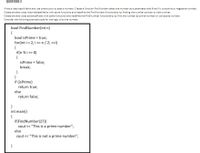
Computer Networking: A Top-Down Approach (7th Edition)
7th Edition
ISBN: 9780133594140
Author: James Kurose, Keith Ross
Publisher: PEARSON
expand_more
expand_more
format_list_bulleted
Question
Write a class basicMaths and use constructor to pass a number. Create a function FindNumber takes one number
as a parameter and Ñnds if it is positive or negatieve number.
Create another class intermediateMaths with same functions and redeÑne the FindNumber functionality by
Ñnding the number as even or odd number.
Create another class advanceMaths with same functions and redeÑne the FindNumber functionality by Ñnd the
number as prime number or composite number.
Consider the following example code for the logic of prime number:

Transcribed Image Text:QUESTION 3
Write a class basicMaths and use constructor to pass a number. Create a function FindNumber takes one number as a parameter and finds if it is positive or negatieve number.
Create another class intermediateMaths with same functions and redefine the FindNumber functionality by finding the number as even or odd number.
Create another class advanceMaths with same functions and redefine the FindNumber functionality by find the number as prime number or composite number.
Consider the foliowing example code for the logic of prime number:
bool FindNumber(int n)
{
bool isPrime = true;
for(int i = 2; i <=n/2; ++i)
{
if(n % i == 0)
{
isPrime = false;
break;
}
if (isPrime)
return true;
else
return false;
int main()
{
if(FindNumber(27))
cout << "This is a prime number";
else
cout << "This is not a prime number";
}
Expert Solution
This question has been solved!
Explore an expertly crafted, step-by-step solution for a thorough understanding of key concepts.
Step by stepSolved in 3 steps with 1 images

Knowledge Booster
Similar questions
- Written in Python It should have an init method that takes two values and uses them to initialize the data members. It should have a get_age method. Docstrings for modules, functions, classes, and methodsarrow_forwardWrite another member function (only) in the previously developed class of SpecialTime in question1, as timeMachine() that takes 02 integer parameters, direction and duration. The direction can have value of -1 or 1 representing going back in time or into the future, respectively. The duration parameter should contain number of minutes to travel in past or future. Add validation to enforce the value of direction as -1 or 1, and value of duration as positive value (number of minutes not exceeding 24 hours). The timeMachine function should return the time your land in (past or future) by adding the received duration into the hour, minute and seconds. Please note that your time machine can only travel upto 24 hours either to the past or to the future. so far my code for the question one is #include<iostream.h># include<conio.h>class time{int hr,min,sec;public: //don't forget it !time(){ hr=min=sec=0; cout<<"Time reset to 00:00:00";}time(int h,int m,int s){ hr =h; min=m;…arrow_forwardImplement a nested class composition relationship between any two class types from the following list: Advisor Вook Classroom Department Friend Grade School Student Teacher Tutor Write all necessary code for both classes to demonstrate a nested composition relationship including the following: a. one encapsulated data member for each class b. inline default constructor using constructor delegation for each class c. inline one-parameter constructor for each class d. inline accessors for all data members e. inline mutators for all data membersarrow_forward
- Create a class called fun. Add to the class a static integer variable called count. Add a constructor that has count++; Add a function getCount() { return count ; } Instantiate 4 instance of the class. F1, F2, F3 and F4. Print out the value of count for each instance. What do you note about the static variable called count ? Filename: week6YourNameProgStaticarrow_forwardWritten in Python with docstring please if applicable Thank youarrow_forwardAccording to the given question, we have to create the test-cases based on the above-given function to test all_fluffy function. all_fluffy_v0 is the correct version and all_fluffy_v1 is the buggy versionarrow_forward
arrow_back_ios
arrow_forward_ios
Recommended textbooks for you
 Computer Networking: A Top-Down Approach (7th Edi...Computer EngineeringISBN:9780133594140Author:James Kurose, Keith RossPublisher:PEARSON
Computer Networking: A Top-Down Approach (7th Edi...Computer EngineeringISBN:9780133594140Author:James Kurose, Keith RossPublisher:PEARSON Computer Organization and Design MIPS Edition, Fi...Computer EngineeringISBN:9780124077263Author:David A. Patterson, John L. HennessyPublisher:Elsevier Science
Computer Organization and Design MIPS Edition, Fi...Computer EngineeringISBN:9780124077263Author:David A. Patterson, John L. HennessyPublisher:Elsevier Science Network+ Guide to Networks (MindTap Course List)Computer EngineeringISBN:9781337569330Author:Jill West, Tamara Dean, Jean AndrewsPublisher:Cengage Learning
Network+ Guide to Networks (MindTap Course List)Computer EngineeringISBN:9781337569330Author:Jill West, Tamara Dean, Jean AndrewsPublisher:Cengage Learning Concepts of Database ManagementComputer EngineeringISBN:9781337093422Author:Joy L. Starks, Philip J. Pratt, Mary Z. LastPublisher:Cengage Learning
Concepts of Database ManagementComputer EngineeringISBN:9781337093422Author:Joy L. Starks, Philip J. Pratt, Mary Z. LastPublisher:Cengage Learning Prelude to ProgrammingComputer EngineeringISBN:9780133750423Author:VENIT, StewartPublisher:Pearson Education
Prelude to ProgrammingComputer EngineeringISBN:9780133750423Author:VENIT, StewartPublisher:Pearson Education Sc Business Data Communications and Networking, T...Computer EngineeringISBN:9781119368830Author:FITZGERALDPublisher:WILEY
Sc Business Data Communications and Networking, T...Computer EngineeringISBN:9781119368830Author:FITZGERALDPublisher:WILEY

Computer Networking: A Top-Down Approach (7th Edi...
Computer Engineering
ISBN:9780133594140
Author:James Kurose, Keith Ross
Publisher:PEARSON

Computer Organization and Design MIPS Edition, Fi...
Computer Engineering
ISBN:9780124077263
Author:David A. Patterson, John L. Hennessy
Publisher:Elsevier Science

Network+ Guide to Networks (MindTap Course List)
Computer Engineering
ISBN:9781337569330
Author:Jill West, Tamara Dean, Jean Andrews
Publisher:Cengage Learning

Concepts of Database Management
Computer Engineering
ISBN:9781337093422
Author:Joy L. Starks, Philip J. Pratt, Mary Z. Last
Publisher:Cengage Learning

Prelude to Programming
Computer Engineering
ISBN:9780133750423
Author:VENIT, Stewart
Publisher:Pearson Education

Sc Business Data Communications and Networking, T...
Computer Engineering
ISBN:9781119368830
Author:FITZGERALD
Publisher:WILEY